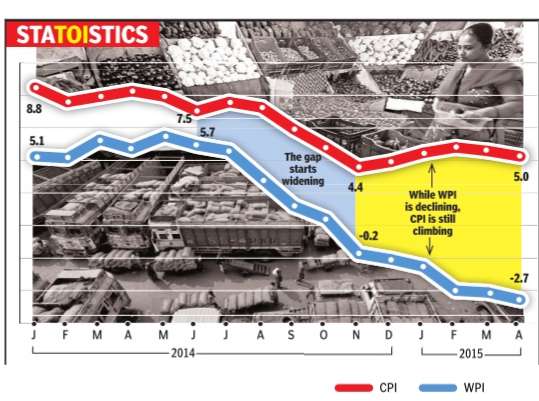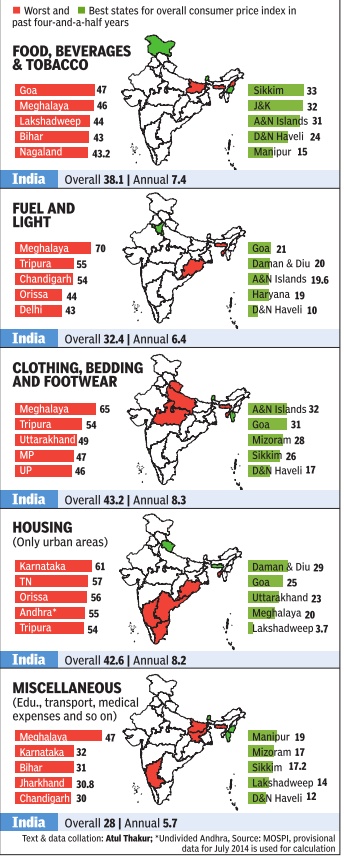Inflation: India
(→Measuring price rise: CPI’s consumption basket) |
(→Measuring price rise: CPI’s consumption basket) |
||
| Line 46: | Line 46: | ||
''' ''Low weightage to pulses in CPI helped check price rise'' ''' | ''' ''Low weightage to pulses in CPI helped check price rise'' ''' | ||
| | ||
| − | |||
'''How is price rise measured?''' | '''How is price rise measured?''' | ||
| − | There are two widely accepted ways of measuring price rise or inflation | + | There are two widely accepted ways of measuring price rise or inflation: the wholesale price index (WPI) and the consumer price index (CPI). The WPI is designed to measure trends of wholesale prices of goods. In short, it tracks the farm and factory gate price of commodities before they reach the retail market. Services are not included in the WPI. The CPI, on the other hand, measures the general level of retail prices of goods and services consumed by households. From a consumer's point of view, it is the CPI that is more meaningful. |
'''What commodities are included in the WPI and what is the base year?''' | '''What commodities are included in the WPI and what is the base year?''' | ||
Revision as of 17:21, 16 September 2015
This is a collection of articles archived for the excellence of their content. |
Contents |
Measuring inflation: Wholesale Price Index (WPI) and Consumer Price Index (CPI)

The Times of India, Jun 08 2015
The Wholesale Price Index (WPI) and Consumer Price Index (CPI) are two ways of measuring inflation. Because of different constituents and weights for them, the inflation rates measured by both indices are often different. What is noticeable in recent months is that the two indices are showing divergent trends. The CPI indicates that there has been a rise in prices, while the WPI suggests that prices have fallen.One reason for this could be that food prices, which constitute a much larger part of the CPI, are up significantly over the last year.SOURCE: MOSPI, Office of the Economic Adviser; Research: Atul Thakur; Graphic: Asheeran Punjabi
Wholesale Price Index (WPI): 1975-2015
The Times of India, Aug 15 2015
Wholesale inflation lowest since '76
Falls for 9th month in a row to -4.1%, longest negative stretch since '75
Wholesale prices plunged for the ninth consecutive month in July on the back of a decline in food and fuel prices, raising prospects of a cut in interest rates to give a push to growth. This was the lowest level of the inflation based on wholesale price index (WPI) since 1976 and, according to economists, is the longest stretch of negative wholesale prices in the country since 1975.WPI inflation was in negative zone for 12 months between July 1975 and June 1976. Data released by the commerce ministry showed the wholesale inflation fell 4.05% in July compared to a decline of 2.40% for the previous month and 5.41% during the corresponding month of the previous year.
The sharp dip in WPI comes close on the heels of the significant moderation in retail inflation in July and together the two data sets have fuelled expectations of a cut in interest rates.
Food inflation fell 1.16% year-on-year in July , while vegetable prices fell 24.52% during the month. The price of pulses continued to remain a worry as it rose 35.75% in July .
India Inc stepped up its call for a reduction in interest rates, citing sharp decline in both WPI and CPI inflation data.“The distinct downturn in both retail and headline inflation and soft inflationary scenario makes a strong case for RBI to resume its accommodative policy stance,“ CII said.
Price rise: Jan 2010-July 2014
Pricey Places
The Times of India Aug 30 2014

Between Jan 2010-July 2014, India has seen retail prices rise 35.6% on average, equivalent to an annual rate of about 7%. But different states have witnessed varying levels of price rise.
Consumer Price Index (CPI)
Measuring price rise: CPI’s consumption basket
The Times of India, Sep 14 2015
Low weightage to pulses in CPI helped check price rise
How is price rise measured?
There are two widely accepted ways of measuring price rise or inflation: the wholesale price index (WPI) and the consumer price index (CPI). The WPI is designed to measure trends of wholesale prices of goods. In short, it tracks the farm and factory gate price of commodities before they reach the retail market. Services are not included in the WPI. The CPI, on the other hand, measures the general level of retail prices of goods and services consumed by households. From a consumer's point of view, it is the CPI that is more meaningful.
What commodities are included in the WPI and what is the base year?
The price index is measured with respect to a particular year called the base year. The base year chosen should be one in which prices were normal and not affected by some unusual natural calamity or international cri sis. For the measure sis. For the measure ment of the current WPI in India, 2004-05 is the base year while for the CPI, 2012 is the base year. The WPI aims to capture all commodity trans actions carried out in the domestic mar ket and hence it in cludes most of them. Weights are assigned to different commodities on the basis of the proportion of that commodity's transactions to all wholesale transactions in the economy .
How is the CPI's consumption basket made?
The consumption basket of the CPI is meant to represent all households in the country. For instance, the new CPI index includes all items which more than 75% of the country's households have reportedly consumed.Weights are assigned to various CPI commodities on the basis of average monthly consumption expenditure on these items discovered as part of a survey.
Why do the CPI and WPI show divergent inflation trends?
According to the latest data, inflation measured at the wholesale level was -4.05% for July , 2015 when compared to July, 2014. For the same period, the combined inflation rate for rural and urban consumers was 7.39%. This anomaly is attributed to several reasons. The most important is the weight of various commodities. For instance, the highest weight in CPI is given to food items, which comprise about 54.2%.In the WPI, the corresponding weight is just 14.3% and hence the high food price inflation that is troubling the country affects this index much less. Apart from this there is a tendency to counter the increase in the cost of raw materials by giving below normal wage increases to workers. In that case, the WPI will be low, but not the CPI.Why are soaring pulse prices not reflected in the CPI? The CPI is based on the actual consumption pattern of households and its composition is revised from time to time, with weights of various commodities changing according to their consumption. If prices of pulses continue to rise rapidly , their weight in the index will also go up unless the price increase is offset by a decline in their consumption. The present CPI food basket, however, gives a higher weight to milk and milk products, vegetables, prepared meals, meat and fish, sugar and spices than to pulses. The low weight for pulses explains why their price increase has only a minor impact on the CPI as a whole.